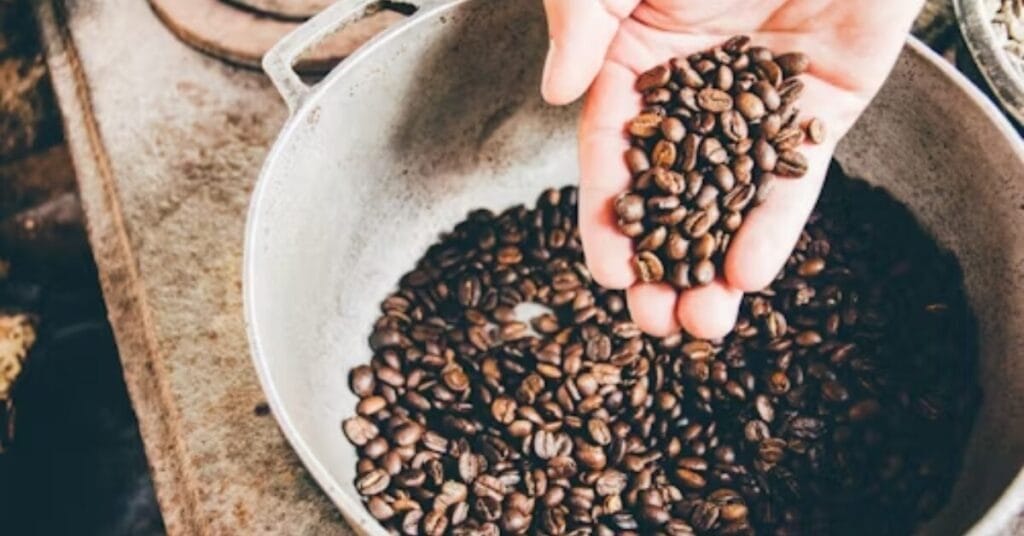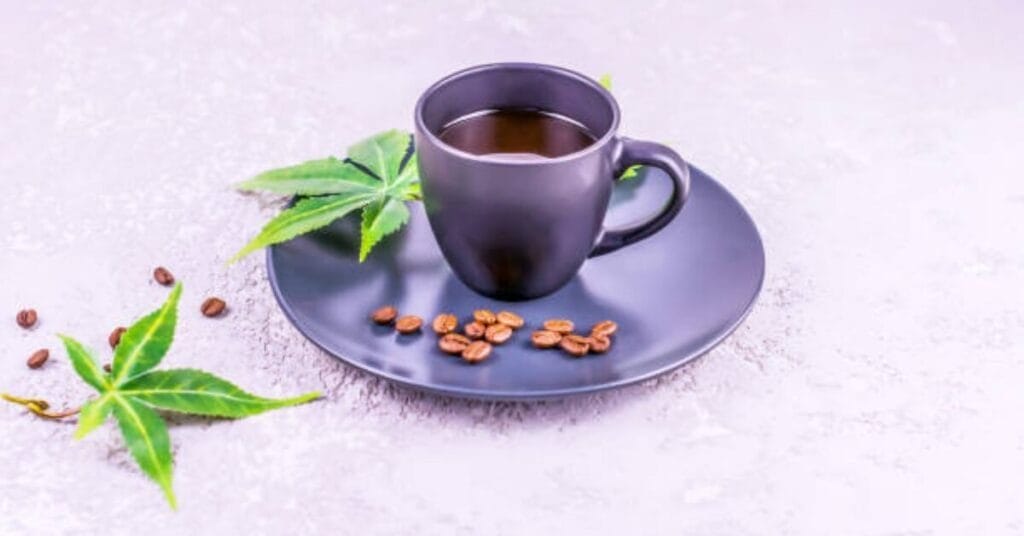Let’s understand “Can you use flavored coffee grounds for plants?” While coffee grounds offer nitrogen benefits, including flavorings raises concerns about potential additives and oils that could harm plants.
Using flavored coffee grounds for plants can be tricky. While coffee grounds benefit some plants due to their nitrogen content, flavored coffee grounds may contain additional additives or oils that could potentially harm your plants. It’s best to avoid using flavored coffee grounds in your garden or composting unless you’re sure they only contain natural flavorings and no harmful additives. Plain coffee grounds are generally safer and can boost your soil’s nitrogen. Still, even then, it’s best to use them in moderation to avoid altering the pH of the soil too much. Suppose you need clarification on whether flavored coffee grounds are safe for your plants. In that case, it’s better to err on the side of caution and stick to plain coffee grounds or other organic fertilizers.
Plants that thrive in acidic soil, like azaleas, blueberries, hydrangeas, rhododendrons, and roses, can be boosted by scattering coffee grounds at their base. Additionally, vegetable crops such as carrots, cucumbers, peppers, potatoes, and radishes may also see benefits from coffee grounds. To utilize coffee grounds as fertilizer, just scatter them around the soil near your plants. Coffee grounds are excellent fertilizer due to their rich nutrient content, which is essential for plant growth. Moreover, they aid in attracting worms and reducing soil heavy metal concentrations. Flavoured coffee may contain calories, varying based on the type and quantity of flavourings added, so it’s essential to review the nutritional information.
As an affiliate site, we are associated with the amazon. We might receive a commission when you use links or recommendations on our website to make qualified purchases. The cost you pay for the goods or services is unaffected by this.
Table of Contents
Can you use Flavored Coffee Grounds for plants: Are Flavored Coffee Grounds good for plants?

Using flavored coffee grounds as a plant fertilizer can be beneficial, but it’s important to be cautious. Flavored coffee grounds often contain added oils, flavorings, and sugars that may not be ideal for all plants. As coffee grounds break down, they can provide nitrogen, potassium, and other nutrients to the soil. However, flavored types might contain substances detrimental to specific plants or attract pests.
If you’re considering using flavored coffee grounds as fertilizers, it’s best to do so sparingly and monitor your plants’ reactions. It’s also a good idea to compost the grounds first, as this can help break down some additives and make them safer for your plants. Mixing flavored coffee grounds with other organic matter can help dilute potentially harmful compounds.
While flavored coffee grounds can benefit plants, it’s essential to use them cautiously and be mindful of their potential effects on your specific plants and soil conditions.
While vinegar can be used as a natural herbicide to control weeds, spraying vinegar directly on tomato plants is generally not recommended. Vinegar is highly acidic, and spraying it on tomato plants can damage the foliage, stems, and possibly fruit.
Tomato plants prefer slightly acidic soil, but applying vinegar directly to the plants can disrupt their pH balance and cause harm. Be cautious when using vinegar in the garden, as it can also affect nearby plants and soil. Suppose you’re dealing with weeds near your tomato plants. In that case, it’s best to use vinegar carefully, avoiding direct contact with the tomatoes. Additionally, consider using other weed control methods such as hand-pulling weeds, mulching, or using herbicides designed explicitly for weed control in vegetable gardens.
While baking soda (sodium bicarbonate) has been a fungicide since 1933, it’s essential to exercise caution. Recent research indicates that while baking soda can be effective against plant diseases when combined with oil, its sodium component can accumulate and become toxic to plants over time. Therefore, it’s advisable to use baking soda as a fungicide sparingly and with consideration for its potential impact on plant health.
Essential oils such as citronella, geranium, lemongrass, eucalyptus, peppermint, and tea tree oil have been studied for their antifungal properties and found to be effective against fungi. However, it’s important to note that while these oils can be helpful as antimicrobials, their efficacy and safety may vary depending on the specific application and concentration used. Always conduct proper research and follow recommended guidelines when using essential oils for fungal control.
While plants require nitrogen (as indicated by the NPK on fertilizers), excessive nitrogen can result in abundant green foliage but limited fruit or berries. Hence, potassium-rich banana peels benefit plants such as tomatoes, peppers, or flowers. Additionally, banana peels contain calcium, which helps prevent blossom end rot in tomatoes.
Flavoured coffee can lose its flavour and aroma over time, making it best to consume within a few weeks to a few months for optimal taste.
Flavoured coffee differs from black coffee as it contains additional flavourings or additives.
Coffee-flavoured foods may or may not include caffeine, depending on whether caffeine is deliberately added as an ingredient.
Flavoured coffee can enhance cold brew, infusing its flavour during brewing for a refreshing take on the traditional cold brew.
It’s generally not advisable to freeze flavoured coffee creamer as it may adversely affect its texture and flavour upon thawing.
What is Flavored Ground Coffee?

Flavored ground coffee refers to coffee beans flavored with various additives or extracts during or after roasting. These additives can include natural or artificial flavorings such as vanilla, caramel, hazelnut, chocolate, or fruit extracts. The flavors are typically infused into the coffee beans to impart a specific taste profile to the brewed coffee. Flavored ground coffee offers a wide range of options for consumers seeking unique or enhanced flavor experiences beyond the traditional taste of plain coffee. It’s popular among those who enjoy experimenting with different flavor combinations in their coffee beverages.
Can Flavored Coffee Grounds be composted?

Yes, flavored coffee grounds can be composted, but there are a few things to remember. The additives and flavorings in flavored coffee grounds may take longer to break down compared to plain coffee grounds. However, these additives will eventually decompose along with the organic matter through the composting process.
Mixing flavored coffee grounds with other organic materials such as yard waste, vegetable scraps, or plain coffee grounds is helpful to ensure the successful composting of flavored coffee grounds. This helps balance the compost pile and provides a variety of nutrients for decomposition. Additionally, make sure your compost pile has the right balance of carbon-rich (such as dried leaves or cardboard) and nitrogen-rich (such as food scraps or coffee grounds) materials, as this aids in the composting process.
Regularly turning and aerating the compost pile will also help speed up decomposition and ensure that the flavored coffee grounds integrate well with the other organic matter. While composting flavored coffee grounds may take a bit longer due to the additives, they can still be a valuable addition to your compost pile and contribute to nutrient-rich compost for your plants.
Can Flavored Coffee Grounds be used as Fertilizer?

Flavored coffee grounds can be used as fertilizers, but some considerations must be considered. Coffee grounds, including flavored ones, contain nitrogen, potassium, and other nutrients that can benefit plants when added to the soil. However, the additives and flavorings in flavored coffee grounds may only be suitable for some plants or could attract pests.
Using flavored coffee grounds as Fertilizer is best if you do so in moderation and monitor your plants’ reactions. Additionally, it’s a good idea to mix the flavored coffee grounds into the soil rather than leaving them on the surface, as this can help prevent pests from being attracted to them.
Before using flavored coffee grounds as fertilizers, it’s also advisable to compost them first. Composting helps break down the additives and flavorings, making them safer for plants and soil. While flavored coffee grounds can provide nutrients to plants, it’s essential to use them cautiously and be aware of their potential effects on your specific plants and soil conditions.
Flavored Coffee Grounds as Worm food?

Using flavored coffee grounds as worm food can be more complex than plain coffee grounds due to the additives and oils in flavored varieties. While worms can consume small amounts of flavored coffee grounds, caution is essential. Certain additives or flavorings could harm the worms or throw off the balance of the worm bin. Suppose you decide to use flavored coffee grounds. In that case, it’s best to do so sparingly and monitor your worm bin closely for any signs of distress or imbalance. Plain coffee grounds are generally safer and provide valuable nutrients for worm composting.
Can plants have Flavored Coffee Grounds?

Plants can potentially have flavored coffee grounds added to their soil, but it’s essential to proceed with caution. While plain coffee grounds can provide beneficial nutrients like nitrogen, flavored varieties may contain additives or oils that could harm the plants. The impact of these additives on plant health is only sometimes clear, and excessive use of flavored coffee grounds could disrupt the balance of the soil or affect plant growth negatively. If considering flavored coffee grounds, starting with small amounts and monitoring the plants for any adverse reactions is advisable. Additionally, using plain coffee grounds is generally a safer option for plant care.
Are Flavored Coffee Grounds reasonable for compost?

Using flavored coffee grounds in compost can be done cautiously, but it’s essential to consider certain factors. Flavored coffee grounds may contain additives or oils that could affect the composting process or the quality of the resulting compost. While small amounts of flavored coffee grounds are unlikely to cause significant harm, using them excessively could disrupt the compost pile’s microbial balance.
It’s generally recommended to prioritize plain coffee grounds for composting to ensure optimal decomposition and nutrient content in the finished compost. However, if using flavored coffee grounds, it’s best to do so sparingly and monitor the compost closely for any signs of issues.
How do you use Flavored Coffee Grounds?

Flavored coffee grounds can be used to create delicious and aromatic coffee beverages. Here’s how you can use them:
- Brewing: Use flavored coffee grounds in your preferred brewing method, whether a drip coffee maker, French press, espresso machine, or pour-over. Follow the instructions on your coffee brewing equipment to achieve the desired strength and flavor.
- Blending: Experiment with blending flavored coffee grounds with other coffee varieties to create unique flavor combinations. Mix them with plain coffee beans or other flavored varieties to customize your brew according to your taste preferences.
- Adding Enhancements: Enhance the flavor of your coffee by adding complementary ingredients such as flavored syrups, spices, or creamers. For example, you could pair hazelnut-flavored coffee grounds with a splash of vanilla syrup for a deliciously indulgent drink.
- Cold Brewing: Use flavored coffee grounds to make cold brew coffee by steeping them in cold water for an extended period, typically 12-24 hours. This method extracts the flavors more slowly, resulting in a smooth and mellow brew with a hint of the chosen flavor.
- Baking: Get creative in the kitchen by incorporating flavored coffee grounds into baked goods like cookies, cakes, or brownies. The subtle flavor of the coffee grounds can add depth and complexity to your favorite recipes, enhancing their overall taste.
- Infusing: Use flavored coffee grounds to infuse other ingredients, such as milk or cream, to create flavored coffee beverages. Simply steep the grounds in the liquid for a few minutes before straining them out to enjoy a subtly flavored drink.
Remember to adjust the quantity of flavored coffee grounds according to your taste preferences, as their intensity can vary depending on the brand and flavor. Experimentation is vital to discovering new and exciting ways to enjoy flavored coffee grounds in your favorite beverages and recipes.
How do you make homemade plant growth boosters?

You can make homemade plant growth boosters using simple and natural ingredients.
Banana Peel Fertilizer:
- Save your banana peels and chop them into small pieces.
- Place the banana peels in a jar and cover them with water.
- Let the mixture sit for a few days to let the nutrients leave.
- Strain the liquid and dilute it with water (1:1 ratio).
- The potassium and other nutrients from the banana peels can promote healthy growth.
Eggshell Calcium Supplement:
- Save and rinse eggshells thoroughly.
- Crush the eggshells into fine powder using a blender or mortar and pestle.
- Sprinkle the crushed eggshells.
- The calcium from the eggshells can help strengthen plant cell walls and prevent diseases like blossom end rot in tomatoes.
Compost Tea:
- Fill a bucket with water and incorporate a shovel full of compost.
- Allow the compost to soak in the water for several days, stirring occasionally.
- Strain the liquid to remove any solid particles.
- Dilute the compost tea with water (1:1 or 1:2 ratio) before watering your plants.
- The nutrients and beneficial microorganisms in the compost tea can improve soil health and promote robust plant growth.
Weed Tea Fertilizer:
- Collect weeds or unwanted plants from your garden (avoid using plants that have gone to seed).
- Fill a bucket with water and add the weeds.
- Let the weeds steep in the water for a few weeks, stirring occasionally.
- Dilute the weed tea with water (1:1 or 1:2 ratio) before watering your plants.
- The nutrients extracted from the weeds can provide a natural fertilizer boost to your plants.
These homemade plant growth boosters are cost-effective and environmentally friendly alternatives to store-bought fertilizers. Remember to apply them in moderation and observe how your plants respond to ensure optimal growth and health.
Here are 10 easy homemade Fertilizer options to try:
- Make Lomi dirt using organic food waste.
- Create homemade organic compost.
- Save and crush leftover eggshells.
- Gather grass clippings for composting.
- Repurpose banana peels as fertilizer.
- Utilize aquarium water for fertilizing.
- Brew compost tea for your plants.
- Use discarded weeds as natural plant food.
- Baking soda can be beneficial for plants in certain situations. When used as a spray solution, it can help prevent fungal diseases like powdery mildew (1 teaspoon of baking soda per 1 quart of water). Still, it should be applied sparingly as excessive use may harm plants or soil pH. Additionally, baking soda can deter pests like aphids when mixed with liquid soap and water. Still, again, it’s essential to use it judiciously to avoid any adverse effects on the plants.
Can you use Flavored Coffee Grounds for Plants: FAQS
Why are Coffee Grounds insufficient for plants?
Coffee grounds are generally unsuitable for direct use on soil due to their high acidity, which can negatively affect various plants, including geraniums, asparagus ferns, Chinese mustard, and Italian ryegrass, inhibiting their growth.
Can I add Cinnamon to the Coffee Grounds?
You can enhance the flavor of your coffee by adding cinnamon sticks to your ground coffee beans. Like vanilla beans infuse aromatics into sugar, cinnamon imparts its flavor to coffee grounds, resulting in a delightful collaboration.
Can I add Vanilla extract to the Coffee Grounds?
Adding vanilla extract to your coffee grounds may seem unconventional. Still, it can impart a smooth and sweet flavor to your coffee, ideal for enjoying as a post-dinner indulgence or kickstarting your morning routine.
Conclusion
In conclusion, “Can you use flavored coffee grounds for plants?” prompts careful consideration of potential benefits and risks. While plain coffee grounds can provide nitrogen to the soil, flavored varieties may contain additives detrimental to plant health.
Also, utilized tea bags serve as a convenient fertilizer due to their tannic acid content, which promotes higher nitrogen levels. Numerous plants, such as roses and potted plants, can benefit from these increased levels, so simply mix or distribute the steeped tea leaves directly onto the soil. You can put baking soda directly on the soil, but using it sparingly and cautiously is essential. Baking soda can adjust soil pH levels slightly, especially if the soil is too acidic. However, excessive use of baking soda can raise the pH of the soil too much, which may harm your plants.
Suppose you’re considering using baking soda on soil. In that case, it’s best to do a soil pH test first to determine if your soil needs it. If you decide to use it, sprinkle a small amount (1 to 2 teaspoons per gallon of water) evenly over the soil surface and water it thoroughly. Monitor your plants closely for signs of stress or adverse effects, and adjust your usage accordingly. Remember that baking soda is not a long-term solution for soil pH management, and it’s important to address underlying soil issues for healthy plant growth.







